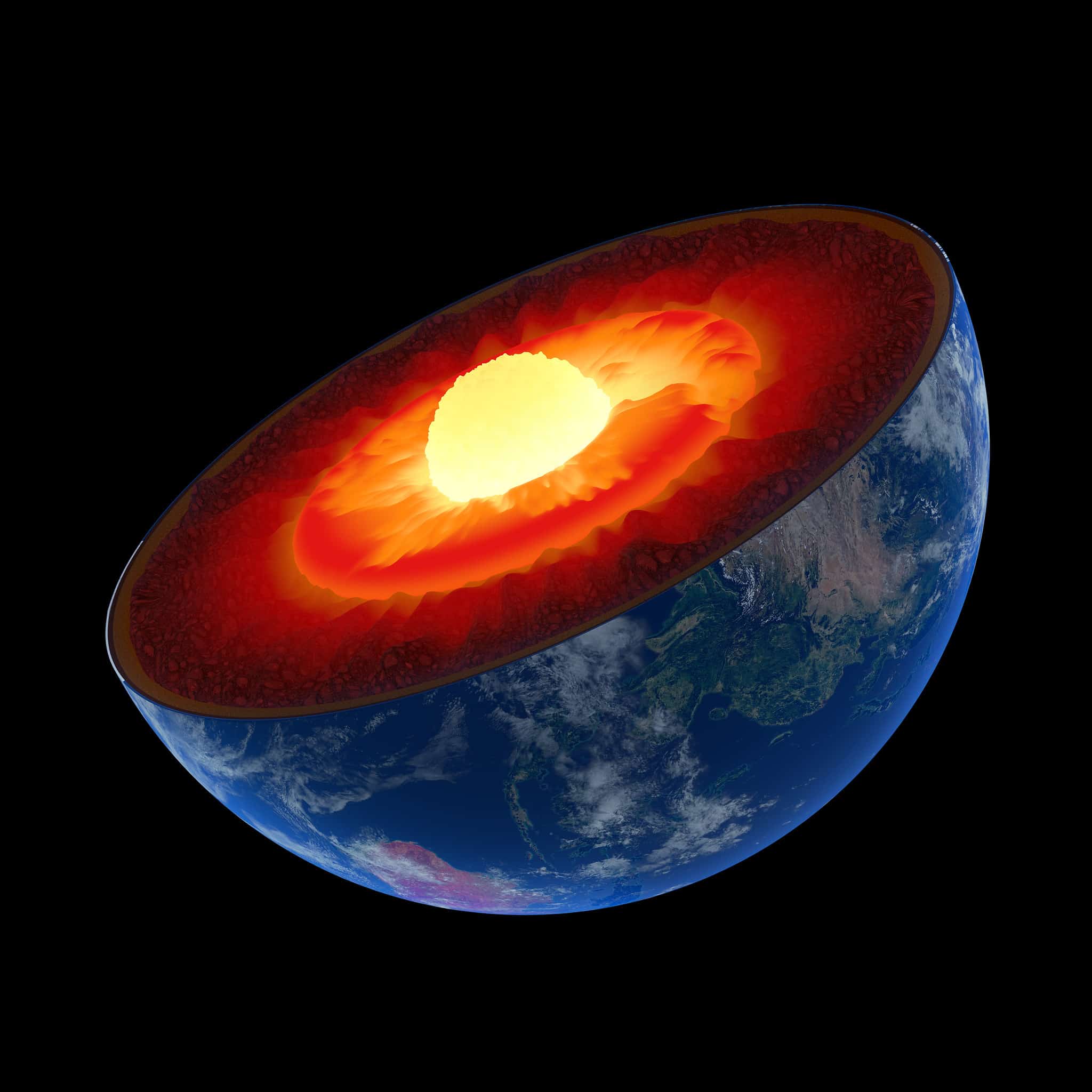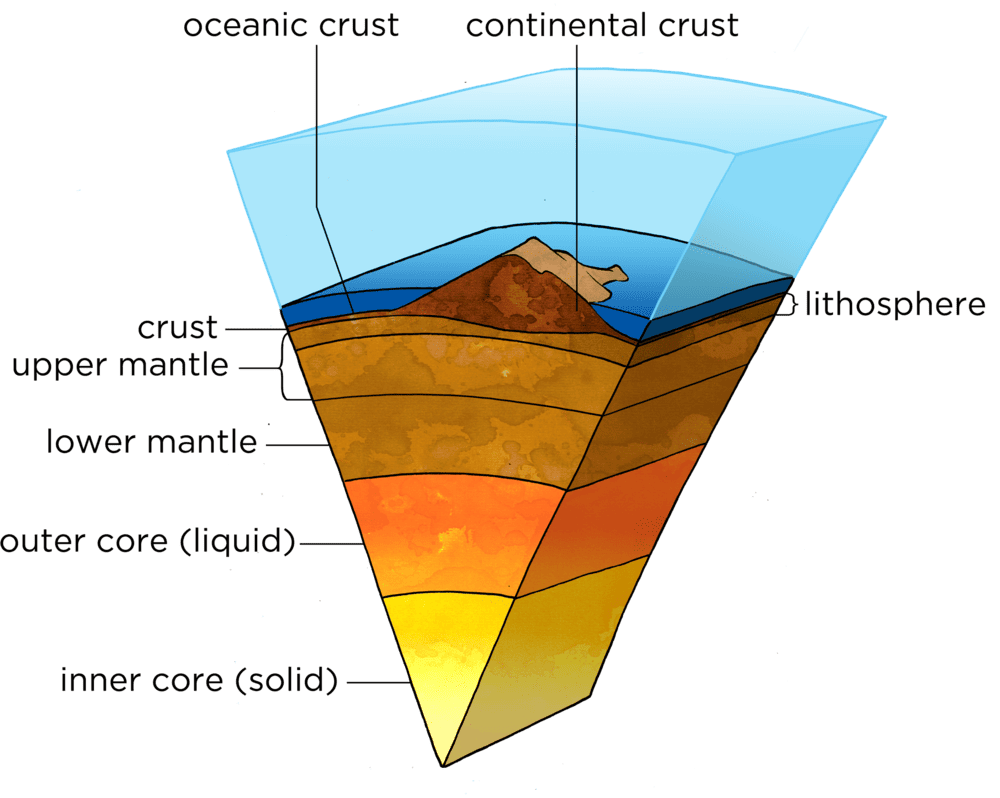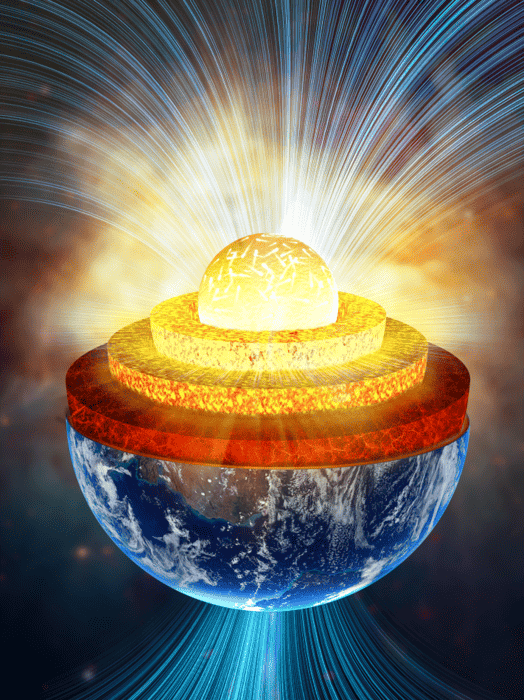Earth’s outer core is a layer of mostly molten metal that lies between the solid inner core and the mantle. This outer core primarily comprises liquid iron and nickel, with some other trace elements. It starts at around 1,800 miles (2,900 kilometers) deep and ends at 3,200 miles (5,150 km) beneath the surface.
This planetary layer is essential for life on Earth as it generates the planet’s magnetic field. Essentially, the molten iron and nickel generate a dynamo effect — this is called the “geodynamo effect”. Without this effect and the magnetic field it produces, life on Earth would be exposed to harmful solar radiation and would likely be unable to evolve. But let’s take it step by step.

The outer core: the inner (but not innermost) layer of the Earth
Consider for a moment the geology you see around you — the valleys, the plains, the mountains. All of them are a part of the Earth’s crust. But the Earth’s crust is a mere fraction of what makes up our planet. The crust is the thinnest of the Earth’s layers, and it’s thinner (proportionally) than the skin on an apple. Imagine what kind of sizes we’re talking about when referring to the core and the mantle!
The core is typically considered as two different layers. The reason is that these two layers (the outer core and the inner core) have different properties. Thinking of the core as two separate layers allows scientists to understand better and explain some of the Earth’s properties and behaviors.
The distinction between the outer core and the inner core isn’t just a matter of depth. It’s a matter of state. While the outer core is a swirling liquid, the inner core is a solid sphere. Yes, even with temperatures that can surpass those of the outer core, the immense pressures at this depth keep the inner core solid. Here’s a summary of some of these differences:
| Aspect | Outer Core | Inner Core |
|---|---|---|
| State of Matter | Liquid | Solid |
| Composition | Iron and nickel; some lighter elements | Primarily iron and nickel; less mixing |
| Dynamics | Fluid motion; contributes to Earth’s magnetic field | Slow rotation; more rigid |
| Temperature | 4,000 to 6,000°C (7,200 to 10,800°F) | 5,000 to 6,000°C (9,000 to 10,800°F) |

A tale of two cores: differences between the outer core and the inner core
Above the outer core lies the mantle. The mantle is a mostly solid layer that extends from the Earth’s crust to a depth of about 1,800 miles. Unlike the iron-rich outer core, the mantle is mainly composed of silicate rocks. Consequently, the mantle is rich in elements like silicon, magnesium, and oxygen. While the mantle might also contain some iron and nickel, these elements are bound in mineral structures rather than in a free-flowing liquid state. The mantle, the thickest layer of the Earth, is also much cooler than the outer core.
Beneath the outer core is the inner core, a solid sphere with a radius of about 1,220 kilometers (758 miles). The temperature in the inner core is about 5,200° Celsius (9,392° Fahrenheit). However, despite this massive temperature, the inner core is solid. The pressure in the inner core is nearly 3.6 million atmospheres — that’s 3.6 million times stronger than the pressure at sea level. For comparison, the pressure at the deepest point on Earth (the Mariana Trench) is “just” over 1,000 atmospheres.
This mammoth pressure doesn’t let the inner core stay liquid. But in the outer core, the pressure is somewhat lower, under 3.3 million atmospheres, which still lets the outer core remain “liquid”. So although the two components of the core are similar from a chemical standpoint, they look quite different physically. Granted, this is not a liquid like water or coffee. It’s more of a thick, viscous, honey-like metallic melt.
Which begs the question: how do we know all of this?
How do we know about the outer core?
The deepest hole mankind has ever dug is just over 12 kilometers deep. So then how do we know what’s happening so deep inside the Earth?
Much (read: almost everything) of what we know about the deep Earth’s interior comes from seismic waves. When an earthquake occurs, it sends out seismic waves all around. Researchers have special sensors called seismographs that can detect these seismic waves and can analyze how the waves propagate through different parts of our planet.

For example, seismic waves behave differently when passing through solid and liquid matter, and this difference helps us learn more about Earth’s internal structure. In particular, one type represented by shear waves doesn’t propagate through liquids — these seismic waves don’t propagate through the outer core. Therefore, we know that the outer core must be “liquid” (again, don’t think it’s like water).
Seismic waves and the inner Earth
In addition to shear waves, there are also compressional waves, also known as P-waves. P-waves can travel through both solid and liquid material but at varying speeds. By measuring the time it takes for P-waves and shear waves to travel through the Earth and arrive at seismic stations located at various points on the surface, scientists can create detailed models of the Earth’s internal structure. This method of study is what we call seismology.
The speed and behavior of these waves provide clues to the type of material they pass through, like a sort of “ultrasound” for the planet. For instance, when P-waves slow down significantly, it’s an indicator that they are passing through a less rigid, or liquid, layer. This is how we deduced the existence of Earth’s liquid outer core and solid inner core.
And it’s not just the core we can learn about! By studying seismic waves, scientists can also get an idea of the varying densities and compositions of the Earth’s mantle and crust, revealing much about its geology and even helping us understand phenomena like plate tectonics.
Why the outer core is important to you
Now, why should you, standing on the seemingly stable surface, care about this deep and distant part of our planet? Well, without the outer core and its dynamic activities, our planet wouldn’t have a protective magnetic field. This magnetic shield protects us from harmful solar radiation. Without it, life as we know it might not exist!
The outer core generates Earth’s magnetic field through a process known as the geodynamo. Imagine this magnetic field as an invisible shield that surrounds the Earth. One of its most crucial functions is to protect the planet from the Sun’s harmful solar wind—charged particles that constantly stream from the Sun. Without this shield, the solar wind would gradually strip away Earth’s atmosphere, making it impossible for life as we know it to survive.

Without magnetism, no life
Earth’s magnetic field indirectly aids in climate stability. A stable climate is vital for ecosystems to flourish and for life forms to adapt. While the magnetic field itself isn’t a climate regulator, its protective role in preserving the atmosphere ensures that mechanisms governing Earth’s climate, like the greenhouse effect, remain intact.
“A strong magnetic field provides a shield for the atmosphere,” said John Tarduno, a geophysicist at the University of Rochester and a leading expert on Earth’s magnetic field, “This is important for the preservation of habitable conditions on Earth.”
Our magnetic field doesn’t just protect us; it helps us navigate. For centuries, explorers have relied on compasses to guide their way. Many animals, such as migratory birds and sea turtles, rely on Earth’s magnetic field for navigation. The natural compass provided by our planet is instrumental for these species to find their way over thousands of kilometers, ensuring their survival and the health of ecosystems.
Without the outer core (or if the outer core would be substantially altered), life on Earth would be dramatically different or would not exist at all.
Additionally, understanding the outer core also helps us delve into Earth’s history and make predictions about geological events, like earthquakes and volcanic activities. While this may not directly sustain life, it certainly contributes to our ability to protect it.
Earth’s Outer Core Facts
The Earth’s outer core is a layer of molten metal located between the Earth’s inner core and the mantle. It plays a crucial role in the planet’s magnetic field and is composed primarily of iron and nickel.
The outer core starts at a depth of approximately 2,890 kilometers (1,800 miles) beneath the Earth’s surface and extends to a depth of about 5,150 kilometers (3,200 miles).
The temperature of the Earth’s outer core ranges between approximately 4,000 and 6,000 degrees Celsius (7,200 to 10,800 degrees Fahrenheit).
The main difference is in their states of matter: the outer core is liquid, while the inner core is solid. The inner core is also hotter and extends from a depth of 5,150 kilometers (3,200 miles) to the Earth’s center at about 6,371 kilometers (3,959 miles).
Scientists use seismic waves from earthquakes to study the Earth’s interior. By examining how these waves pass through or are reflected by different layers, they can make educated guesses about the composition of the outer core.
The motion of the molten metal in the Earth’s outer core generates the Earth’s magnetic field. This magnetic field protects the planet from harmful solar radiation and helps in navigation and orientation.
If the Earth’s outer core stopped moving, it would lead to the collapse of the Earth’s magnetic field. This would have catastrophic implications, including increased exposure to solar radiation and potential loss of the atmosphere over time.
Yes, the fluid dynamics of the outer core are believed to interact with the Earth’s rotation, although the precise relationship is still an area of ongoing research.
While the outer core is not directly involved in climate processes, its role in maintaining the Earth’s magnetic field indirectly influences the climate by protecting the atmosphere.
Reaching the Earth’s outer core would require drilling through thousands of kilometers of solid rock and then entering a high-pressure, high-temperature environment of molten metal. With current technology, this is not feasible.
In Conclusion: Celebrating the Core of Our World
Our Earth is a marvel, with mysteries and wonders extending far below the ground you walk on. The outer core, with its molten magic and its role in shaping our planet’s character, is a testament to the dynamic nature of our world. The dance of molten metal that swirls deep beneath you, protects, guides, and gives our planet its magnetic charm.






